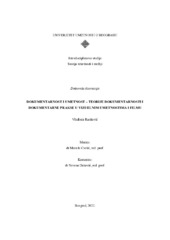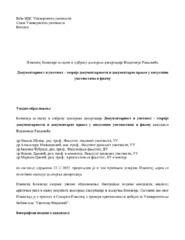| dc.contributor.advisor | Цветић, Мариела | |
| dc.contributor.other | Миловановић, Александра | |
| dc.contributor.other | Шуица, Никола | |
| dc.contributor.other | Чубрило, Јасмина | |
| dc.creator | Ранковић, Владимир | |
| dc.date.accessioned | 2023-01-17T13:15:07Z | |
| dc.date.available | 2023-01-17T13:15:07Z | |
| dc.date.issued | 2023-05-04 | |
| dc.date.submitted | 2023-01-17 | |
| dc.identifier.uri | http://eteze.arts.bg.ac.rs/handle/123456789/589 | |
| dc.description.abstract | Primarni cilj doktorske disertacije „Dokumentarnost i umetnost – teorije dokumentarnosti
i dokumentarne prakse u vizuelnim umetnostima i filmu” jeste (re)definisanje teorijskih okvira u
kojima se dokumentarnost može razmatrati u kontekstu umetničkih praksi vizuelnih umetnosti i
filma, utvrđivanje premisa neophodnih za postojanje dokumentarnog kao dela sveta umetnosti,
kao i analiza zastupljenosti i uloge dokumentarističkih strategija u umetničkim praksama, odnosno
determinisanje promena teorijske i istorijske kontekstualizacije dokumentarnog kao konstituenta
umetnosti. Pored toga, kao cilj rada, uzimajući u obzir teorijske pristupe umetnosti proistekle iz
umetničkih praksi, postavlja se i ispitivanje dokumentarističkih umetničkih strategija i procedura
kao delatnih elemenata savremenih umetničkih praksi sposobnih da menjaju i redefinišu prirodu,
ulogu i poziciju umetnosti.
Rad polazi od utvrđivanja ključnih pojmova, modela i kriterijuma neophodnih za
definisanje i pozicioniranje dokumentarnosti u kontekstu istorije i teorije umetnosti, pri čemu se
oslanja na određena književno-teorijska razmatranja, filozofske, estetičke i hermeneutičke
pristupe, kao i na komparativnu analizu diskursa istorije, kao paradigmatičnog neizmišljenog
narativa, i diskursa umetnosti. Potom, kroz analizu relacija umetnosti sa stvarnim subjektima,
odnosno umetnosti kao kreativne obrade stvarnosti, dokumentarnost se razmatra u kontekstu
teorija reprezentacije, teorijsko-kritičkog diskursa alegorije adekvatnog karakteru umetnosti
postmodernističkog predznaka, kao i posmatrana kroz prizmu procesa objektivnog, mehaničkog,
impersonalnog beleženja stvarnosti, uvođenja umetničke dokumentacije kao činioca određenih
savremenih umetničkih praksi u instutucije umetnosti i, naposletku, kao proces proizvodnje
hibridnih fikcionalnih narativa koji preuzimaju pojavnost dokumentarnog, dokumentarističke
kodove i konvencije.
Kako se istorija umetnosti u većem delu svoga toka može recipirati kao pripovest o
osvajanju stvarnog o dokumentarnom kao o apsolutnoj kategoriji može se govoriti tek po osvajanju
stvarnog, odnosno po okončanju tog procesa otkrićem fotografije, a potom i inkorporiranju onoga
što je proisteklo iz takvog osvajanja u umetnost. Dokumentarno se, na osnovu toga, može odrediti
4
kao post-avangardna pojava za čije ustanovljavanje je, u kontekstu umetničkih praksi, bilo
neophodno osloboditi se uslovljenosti realnosti, a potom učiniti da ishodi takvog oslobađanja
budu asimilirani od strane umetnosti, odnosno transformisani u umetnost.
Danas, u doba u kojem ljudski rod, kao nikada pre nije toliko zainteresovan za svoju
sadašnjost, dokumentarnost kao pojava u kontekstu umetničkih praksi zauzima izuzetno značajnu
poziciju. Imajući u vidu nebrojene, raznorodne strategije usmerene ka cilju da se razlikovanje
fikcije i stvarnosti učini što težim, javlja se zapitanost, koja, čini se, postaje imanentna recepciji
proizvoda umetničkog delovanja, o tome da li predstavljeno treba doživeti kao stvarno,
neizmišljeno. Otuda, ključna determinanta dokumentarnosti – funkcija da pruži potporu o
relevantnosti izvora i istinitosti predočenog sadržaja, održavajući korak sa globalnim promenama, i
sama prolazi kroz promene, postaje fluidna, pronalazeći načine odgovori potrebama sveta
umetnosti, redefinišući prirodu, ulogu i poziciju umetnosti. | en |
| dc.description.abstract | The primary goal of the doctoral dissertation “Documentarity and Art – Theories of
Documentarity and Documentary Practices in Visual Arts and Film” is to (re)define theoretical
frameworks within which documentarity can be scrutinized in the context of art practices of
visual arts and film, determining premises necessary for the existence of a documentary as a part
of the artworld, as well as analysis of the prevalence and role of documentary strategies in art
practices, i.e. determining changes of theoretical and historical contextualization of a documentary
as an art constituent. Moreover, bearing in mind theoretical approaches of art originating from art
practices, the goal of the thesis is also to raise a question concerning the evaluation of documentary
art strategies and procedures as working elements of the contemporary art practices able to alter and
redefine the nature, the role and the position of art.
The thesis opens with determining key terms, models, and criteria essential for defining
and positioning documentarity in the context of art history and theory, simultaneously building
upon specific literary and theoretical scrutiny, philosophical, aesthetical, and hermeneutical
approaches, in addition to comparative analysis of historical discourse, as paradigmatic nonfictional
narrative, and art discourse. Furthermore, documentarity is not only studied by means of
analyzing relations between art and fact, i.e, art as creative treatment of actuality, in a context of
theories of representation and the theoretical and critical discourse of allegory which corresponds
to the character of postmodernly oriented art, but it is also observed through a prism of a process
of objective, mechanical, impersonal recording of reality, introducing art documentation as an
agent of certain contemporary art practices into art institutions, and finally, as a process of
producing hybrid fictional narratives which take over manifestations of documentarity,
documentarictic codes, and conventions.
Since art history may be perceived as a story about the conquering of reality throughout
most of its existence, documentarity may consequently be discussed as an absolute category only
after the conquering of reality, that is, after the completion of the said process by discovery of
photography, and afterwards by incorporating that which came as a result of the mentioned
6
conquering into art. Based on this, documentarity may be characterized as a post avant-garde
phenomenon, the establishing of which, in a context of art practices, required freeing from
dependence on reality followed by assimilation of the results of such freeing by art itself, i.e.,
transformed into art.
Nowadays, with the human race as keen on living in its present moment as never before,
documentarity occupies an extremely significant position as a manifestation in the context of art
practices. Bearing in mind a multitude of diverse strategies determined to make any attempt at
discerning fiction from reality as hard as possible, a question is being raised, seemingly immanent
to a reception of a product of any artistic endeavor, whether the exhibited content is to be
interpreted as real, non-fictional. Hence, documetarity’s key frame of reference – a function of
providing a foundation for both relevance of source and truthfulness of the displayed content,
keeping abreast of global changes, itself passes through changes, becomes fluid, finding ways of
responding to needs of artworld, redefining the nature, the role, and the position of art. | en |
| dc.language.iso | sc | en |
| dc.publisher | Универзитет уметности у Београду, Интердисциплинарне студије Универзитета уметности | sr |
| dc.source | Интердисциплинарне студије Универзитета уметности | sr |
| dc.subject | dokument, dokumentarnost, reprezentacija, alegorija, fotografija, film, aproprijacija, umetnička dokumentacija, pseudodokumentarnost, savremena umetnost | en |
| dc.subject | document, documentarity, representation, allegory, photography, film, appropriation, art documentation, pseudo-documentarity, contemporary art | en |
| dc.title | Документарност и уметност - теорије документарности и документарне праксе у визуелним уметностима и филму | en |
| dc.type | doctoralThesis | en |
| dc.contributor.coadvisor | Даковић, Невена | |


